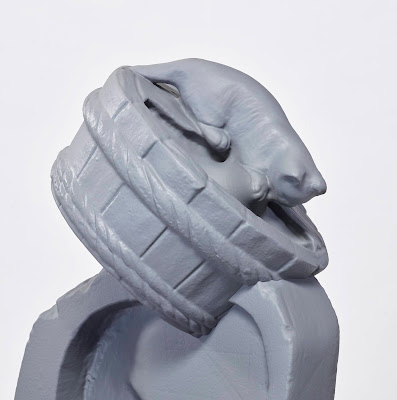貓捉老鼠 Cat and Mouse
單頻道錄像裝置 single-channel video installation、3D列印模型 3D printing model、特製展示櫃 customised showcase,6'30",81.5 (W) x 86 (L) x 120 (H) cm,2020
Cat and Mouse is a work of art that connects the history of Taiwan's "White Terror" era with archaeological history. In 1948, amateur archaeologist Wang San-pai (courtesy name Hong-bo) travelled to the Nanshikeng settlement located on the western slopes of Dadu Plateau and discovered prehistoric tableware, porcelain, and animal bones, thus naming the newly unearthed community the "Nanshikeng Site." However, this astounding archaeological project was discontinued due to the political climate of the time. Specifically, Wang San-pai was sentenced to prison for political reasons and executed in 1953, putting a screeching stop to a budding discovery. It was not until 2001 that the archaeological site was once again formally excavated under the direction of Dr Chu Whei-lee of the National Museum of Natural Science.
The video is a recording of the artist's visit to Taichung and an interview with Mr Wang San-pai's daughter, Master Chang Tsz, who revealed precious manuscripts, including Mr Wang San-pai's field survey reports on the Nanshikeng Site as well as the calligraphy works and letters he had written while imprisoned. She also presented a unique inkstone Mr Wang had hand-chiselled from a rock he had found while still attending elementary school. This long-cherished childhood object shows his profound interest in field research and archaeology. Another item in his collections is a piece of pottery depicting a cat and a mouse that alludes to the political climate during Mr Wang's lifetime. The artist utilized 3D scanning technology to convert images of the inkstone and pottery piece into digital data, then created the installation using 3D printing, harnessing the powers of modern technology to reveal this complex, intertwining piece of history between archaeology and politics.
《貓捉老鼠》這件作品串起台灣白色恐怖時期歷史與考古歷史之間的關聯。在1948年間,業餘考古學家王參派先生(字鴻博)來到位於大肚山西麓的南勢坑聚落,發現一些食器、陶器及獸骨,將此新發現的遺址稱為南勢坑遺址。但是在當時的政治局勢下,這個考古研究並無法延續,因為王參派先生因政治因素被控入獄,最終在1953年被處決,成為他個人的未竟之業。直到2001年,這個考古遺址才在國立自然科學博物館的屈慧麗博士的主持下,再次進行深入的發掘。
影片紀錄著藝術家前往台中拜訪王參派先生的女兒常慈師父的過程,師父展示了王參派先生珍貴的南勢坑田野調查報告手稿、入獄時所寫的書法與家書。其中還有一塊獨特的硯台,是王參派先生在其小學時,自己用撿到的石頭所鑿製而成。似乎他對田野物件及考古的興趣,從這兒時的物件上就可看出一些端倪。此外還有另一個遺物是王參派先生所收藏的貓捉老鼠陶皿,也反映了當時的時空背景。藝術家利用3D掃描技術將此硯台與陶皿轉化成數位資料,並以3D列印的方式製作了裝置,以當代技術轉化這段考古與政治糾結的歷史。









沒有留言:
發佈留言